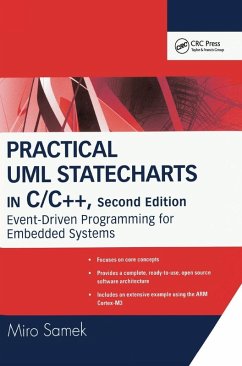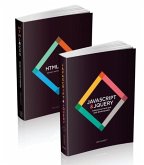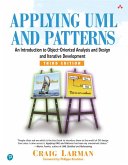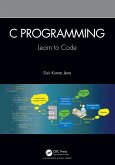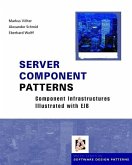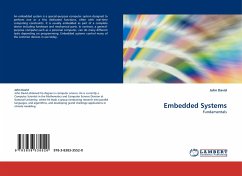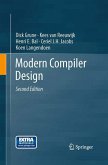- Gebundenes Buch
- Merkliste
- Auf die Merkliste
- Bewerten Bewerten
- Teilen
- Produkt teilen
- Produkterinnerung
- Produkterinnerung
Describes a lightweight, open source infrastructure, called QP that enables direct manual coding UML statecharts and concurrent event-driven applications in C or C++ without big tools. This book focuses on core concepts rather than tools which are always changing allowing the reader to continue to use this information with various projects.
Andere Kunden interessierten sich auch für
![Web Design with HTML, CSS, JavaScript and jQuery Set Web Design with HTML, CSS, JavaScript and jQuery Set]() Jon DuckettWeb Design with HTML, CSS, JavaScript and jQuery Set43,99 €
Jon DuckettWeb Design with HTML, CSS, JavaScript and jQuery Set43,99 €![Applying UML and Patterns Applying UML and Patterns]() Craig LarmanApplying UML and Patterns57,99 €
Craig LarmanApplying UML and Patterns57,99 €![C Programming C Programming]() Sisir Kumar JenaC Programming153,99 €
Sisir Kumar JenaC Programming153,99 €![Server Component Patterns Server Component Patterns]() Markus VölterServer Component Patterns59,99 €
Markus VölterServer Component Patterns59,99 €![Embedded Systems Embedded Systems]() John DavidEmbedded Systems33,99 €
John DavidEmbedded Systems33,99 €![Modern Compiler Design Modern Compiler Design]() Dick GruneModern Compiler Design67,99 €
Dick GruneModern Compiler Design67,99 €![Java Programming Exercises Java Programming Exercises]() Christian UllenboomJava Programming Exercises185,99 €
Christian UllenboomJava Programming Exercises185,99 €-
-
-
Describes a lightweight, open source infrastructure, called QP that enables direct manual coding UML statecharts and concurrent event-driven applications in C or C++ without big tools. This book focuses on core concepts rather than tools which are always changing allowing the reader to continue to use this information with various projects.
Hinweis: Dieser Artikel kann nur an eine deutsche Lieferadresse ausgeliefert werden.
Hinweis: Dieser Artikel kann nur an eine deutsche Lieferadresse ausgeliefert werden.
Produktdetails
- Produktdetails
- Verlag: CRC Press
- 2nd edition
- Seitenzahl: 744
- Erscheinungstermin: 4. April 2018
- Englisch
- Abmessung: 244mm x 170mm x 40mm
- Gewicht: 1383g
- ISBN-13: 9781138436381
- ISBN-10: 1138436380
- Artikelnr.: 53693734
- Herstellerkennzeichnung
- Libri GmbH
- Europaallee 1
- 36244 Bad Hersfeld
- gpsr@libri.de
- Verlag: CRC Press
- 2nd edition
- Seitenzahl: 744
- Erscheinungstermin: 4. April 2018
- Englisch
- Abmessung: 244mm x 170mm x 40mm
- Gewicht: 1383g
- ISBN-13: 9781138436381
- ISBN-10: 1138436380
- Artikelnr.: 53693734
- Herstellerkennzeichnung
- Libri GmbH
- Europaallee 1
- 36244 Bad Hersfeld
- gpsr@libri.de
Dr. Miro Samek is the founder and president of Quantum Leaps, an open source company providing lightweight, state machine-based, event-driven application frameworks for embedded systems. He is the author of Practical Statecharts in C/C++ (CMP Books, 2002), has written numerous articles for magazines, including a column for C/C++ Users Journal, is a regular speaker at the Embedded Systems Conferences, and serves on the editorial review board of the Embedded Systems Design magazine. For a number of years, he worked in various Silicon Valley companies as an embedded software architect and before that he worked as an embedded software engineer at GE Medical Systems (now GE Healthcare). Dr. Samek earned his Ph.D. in nuclear physics at GSI (Darmstadt, Germany).
Preface PART I STATECHARTS Chapter 1 Whirlwind Tour of Programming with
Statecharts1.1 Why Bother?1.2 The Traditional Event-Action Paradigm1.3
State Machines ? A Better Way of Programming1.3.1 The Time Bomb
Example1.3.2 The Calculator Example1.5 Object-Oriented Analogy1.6 The
Event-driven Framework1.6 SummaryChapter 2 A Crash Course in Statecharts
2.1 The Essence of Finite State Machines2.2 The Essence of UML
Statecharts2.3 Examples of State Models2.4 SummaryChapter 3 Standard State
Machine Implementations3.1 State Machine Interface3.2 Nested switch
Statement3.3 State Table3.4 State Design Pattern3.5 Optimal FSM
Implementation3.6 State Machines and C++ Exception Handling 3.7 Role of
Pointer-to-Member Functions3.8 Implementing Guards, Junctions, and Choice
Points3.9 Implementing Entry and Exit Actions3.10 Dealing with State
Hierarchy3.11 SummaryChapter 4 QEP: A Minimal Hierarchical Event
Processor4.1 General Structure of the QEP Event Processor4.2 An Annotated
Example (QHsm)4.3 QEP Structure4.3.1 QEP Source Code Structure4.3.2
Internal Representation of a State Machine4.3.3 Initialization of a State
Machine4.3.4 Dispatching Events to a FSM4.3.5 Executing a Transition in a
FSM4.3.6 Dispatching Events to a HSM4.3.7 Executing a Transition in a
HSM4.3.8 Static Transition Optimization in a HSM4.4 Porting and Configuring
QEP4.5 Caveats4.6 Su
Statecharts1.1 Why Bother?1.2 The Traditional Event-Action Paradigm1.3
State Machines ? A Better Way of Programming1.3.1 The Time Bomb
Example1.3.2 The Calculator Example1.5 Object-Oriented Analogy1.6 The
Event-driven Framework1.6 SummaryChapter 2 A Crash Course in Statecharts
2.1 The Essence of Finite State Machines2.2 The Essence of UML
Statecharts2.3 Examples of State Models2.4 SummaryChapter 3 Standard State
Machine Implementations3.1 State Machine Interface3.2 Nested switch
Statement3.3 State Table3.4 State Design Pattern3.5 Optimal FSM
Implementation3.6 State Machines and C++ Exception Handling 3.7 Role of
Pointer-to-Member Functions3.8 Implementing Guards, Junctions, and Choice
Points3.9 Implementing Entry and Exit Actions3.10 Dealing with State
Hierarchy3.11 SummaryChapter 4 QEP: A Minimal Hierarchical Event
Processor4.1 General Structure of the QEP Event Processor4.2 An Annotated
Example (QHsm)4.3 QEP Structure4.3.1 QEP Source Code Structure4.3.2
Internal Representation of a State Machine4.3.3 Initialization of a State
Machine4.3.4 Dispatching Events to a FSM4.3.5 Executing a Transition in a
FSM4.3.6 Dispatching Events to a HSM4.3.7 Executing a Transition in a
HSM4.3.8 Static Transition Optimization in a HSM4.4 Porting and Configuring
QEP4.5 Caveats4.6 Su
Preface PART I STATECHARTS Chapter 1 Whirlwind Tour of Programming with Statecharts1.1 Why Bother?1.2 The Traditional Event-Action Paradigm1.3 State Machines ? A Better Way of Programming1.3.1 The Time Bomb Example1.3.2 The Calculator Example1.5 Object-Oriented Analogy1.6 The Event-driven Framework1.6 SummaryChapter 2 A Crash Course in Statecharts 2.1 The Essence of Finite State Machines2.2 The Essence of UML Statecharts2.3 Examples of State Models2.4 SummaryChapter 3 Standard State Machine Implementations3.1 State Machine Interface3.2 Nested switch Statement3.3 State Table3.4 State Design Pattern3.5 Optimal FSM Implementation3.6 State Machines and C++ Exception Handling 3.7 Role of Pointer-to-Member Functions3.8 Implementing Guards, Junctions, and Choice Points3.9 Implementing Entry and Exit Actions3.10 Dealing with State Hierarchy3.11 SummaryChapter 4 QEP: A Minimal Hierarchical Event Processor4.1 General Structure of the QEP Event Processor4.2 An Annotated Example (QHsm)4.3 QEP Structure4.3.1 QEP Source Code Structure4.3.2 Internal Representation of a State Machine4.3.3 Initialization of a State Machine4.3.4 Dispatching Events to a FSM4.3.5 Executing a Transition in a FSM4.3.6 Dispatching Events to a HSM4.3.7 Executing a Transition in a HSM4.3.8 Static Transition Optimization in a HSM4.4 Porting and Configuring QEP4.5 Caveats4.6 Su
Preface PART I STATECHARTS Chapter 1 Whirlwind Tour of Programming with
Statecharts1.1 Why Bother?1.2 The Traditional Event-Action Paradigm1.3
State Machines ? A Better Way of Programming1.3.1 The Time Bomb
Example1.3.2 The Calculator Example1.5 Object-Oriented Analogy1.6 The
Event-driven Framework1.6 SummaryChapter 2 A Crash Course in Statecharts
2.1 The Essence of Finite State Machines2.2 The Essence of UML
Statecharts2.3 Examples of State Models2.4 SummaryChapter 3 Standard State
Machine Implementations3.1 State Machine Interface3.2 Nested switch
Statement3.3 State Table3.4 State Design Pattern3.5 Optimal FSM
Implementation3.6 State Machines and C++ Exception Handling 3.7 Role of
Pointer-to-Member Functions3.8 Implementing Guards, Junctions, and Choice
Points3.9 Implementing Entry and Exit Actions3.10 Dealing with State
Hierarchy3.11 SummaryChapter 4 QEP: A Minimal Hierarchical Event
Processor4.1 General Structure of the QEP Event Processor4.2 An Annotated
Example (QHsm)4.3 QEP Structure4.3.1 QEP Source Code Structure4.3.2
Internal Representation of a State Machine4.3.3 Initialization of a State
Machine4.3.4 Dispatching Events to a FSM4.3.5 Executing a Transition in a
FSM4.3.6 Dispatching Events to a HSM4.3.7 Executing a Transition in a
HSM4.3.8 Static Transition Optimization in a HSM4.4 Porting and Configuring
QEP4.5 Caveats4.6 Su
Statecharts1.1 Why Bother?1.2 The Traditional Event-Action Paradigm1.3
State Machines ? A Better Way of Programming1.3.1 The Time Bomb
Example1.3.2 The Calculator Example1.5 Object-Oriented Analogy1.6 The
Event-driven Framework1.6 SummaryChapter 2 A Crash Course in Statecharts
2.1 The Essence of Finite State Machines2.2 The Essence of UML
Statecharts2.3 Examples of State Models2.4 SummaryChapter 3 Standard State
Machine Implementations3.1 State Machine Interface3.2 Nested switch
Statement3.3 State Table3.4 State Design Pattern3.5 Optimal FSM
Implementation3.6 State Machines and C++ Exception Handling 3.7 Role of
Pointer-to-Member Functions3.8 Implementing Guards, Junctions, and Choice
Points3.9 Implementing Entry and Exit Actions3.10 Dealing with State
Hierarchy3.11 SummaryChapter 4 QEP: A Minimal Hierarchical Event
Processor4.1 General Structure of the QEP Event Processor4.2 An Annotated
Example (QHsm)4.3 QEP Structure4.3.1 QEP Source Code Structure4.3.2
Internal Representation of a State Machine4.3.3 Initialization of a State
Machine4.3.4 Dispatching Events to a FSM4.3.5 Executing a Transition in a
FSM4.3.6 Dispatching Events to a HSM4.3.7 Executing a Transition in a
HSM4.3.8 Static Transition Optimization in a HSM4.4 Porting and Configuring
QEP4.5 Caveats4.6 Su
Preface PART I STATECHARTS Chapter 1 Whirlwind Tour of Programming with Statecharts1.1 Why Bother?1.2 The Traditional Event-Action Paradigm1.3 State Machines ? A Better Way of Programming1.3.1 The Time Bomb Example1.3.2 The Calculator Example1.5 Object-Oriented Analogy1.6 The Event-driven Framework1.6 SummaryChapter 2 A Crash Course in Statecharts 2.1 The Essence of Finite State Machines2.2 The Essence of UML Statecharts2.3 Examples of State Models2.4 SummaryChapter 3 Standard State Machine Implementations3.1 State Machine Interface3.2 Nested switch Statement3.3 State Table3.4 State Design Pattern3.5 Optimal FSM Implementation3.6 State Machines and C++ Exception Handling 3.7 Role of Pointer-to-Member Functions3.8 Implementing Guards, Junctions, and Choice Points3.9 Implementing Entry and Exit Actions3.10 Dealing with State Hierarchy3.11 SummaryChapter 4 QEP: A Minimal Hierarchical Event Processor4.1 General Structure of the QEP Event Processor4.2 An Annotated Example (QHsm)4.3 QEP Structure4.3.1 QEP Source Code Structure4.3.2 Internal Representation of a State Machine4.3.3 Initialization of a State Machine4.3.4 Dispatching Events to a FSM4.3.5 Executing a Transition in a FSM4.3.6 Dispatching Events to a HSM4.3.7 Executing a Transition in a HSM4.3.8 Static Transition Optimization in a HSM4.4 Porting and Configuring QEP4.5 Caveats4.6 Su

